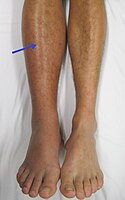
Photo from wikipedia
Here we analyze hospitalized andintensive care unit coronavirus disease 2019 (COVID‐19) patient outcomes from the international VIRUS registry (https://clinicaltrials.gov/ct2/show/NCT04323787). We find that COVID‐19 patients administered unfractionated heparin but not enoxaparin… Click to show full abstract
Here we analyze hospitalized andintensive care unit coronavirus disease 2019 (COVID‐19) patient outcomes from the international VIRUS registry (https://clinicaltrials.gov/ct2/show/NCT04323787). We find that COVID‐19 patients administered unfractionated heparin but not enoxaparin have a higher mortality‐rate (390 of 1012 = 39%) compared to patients administered enoxaparin but not unfractionated heparin (270 of 1939 = 14%), presenting a risk ratio of 2.79 (95% confidence interval [CI]: [2.42, 3.16]; p = 4.45e−52). This difference persists even after balancing on a number of covariates including demographics, comorbidities, admission diagnoses, and method of oxygenation, with an increased mortality rate on discharge from the hospital of 37% (268 of 733) for unfractionated heparin versus 22% (154 of 711) for enoxaparin, presenting a risk ratio of 1.69 (95% CI: [1.42, 2.00]; p = 1.5e−8). In these balanced cohorts, a number of complications occurred at an elevated rate for patients administered unfractionated heparin compared to patients administered enoxaparin, including acute kidney injury, acute cardiac injury, septic shock, and anemia. Furthermore, a higher percentage of Black/African American COVID patients (414 of 1294 [32%]) were noted to receive unfractionated heparin compared to White/Caucasian COVID patients (671 of 2644 [25%]), risk ratio 1.26 (95% CI: [1.14, 1.40]; p = 7.5e−5). After balancing upon available clinical covariates, this difference in anticoagulant use remained statistically significant (311 of 1047 [30%] for Black/African American vs. 263 of 1047 [25%] for White/Caucasian, p = .02, risk ratio 1.18; 95% CI: [1.03, 1.36]). While retrospective studies cannot suggest any causality, these findings motivate the need for follow‐up prospective research into the observed racial disparity in anticoagulant use and outcomes for severe COVID‐19 patients.
Journal Title: Journal of Medical Virology
Year Published: 2021
Link to full text (if available)
Share on Social Media: Sign Up to like & get
recommendations!